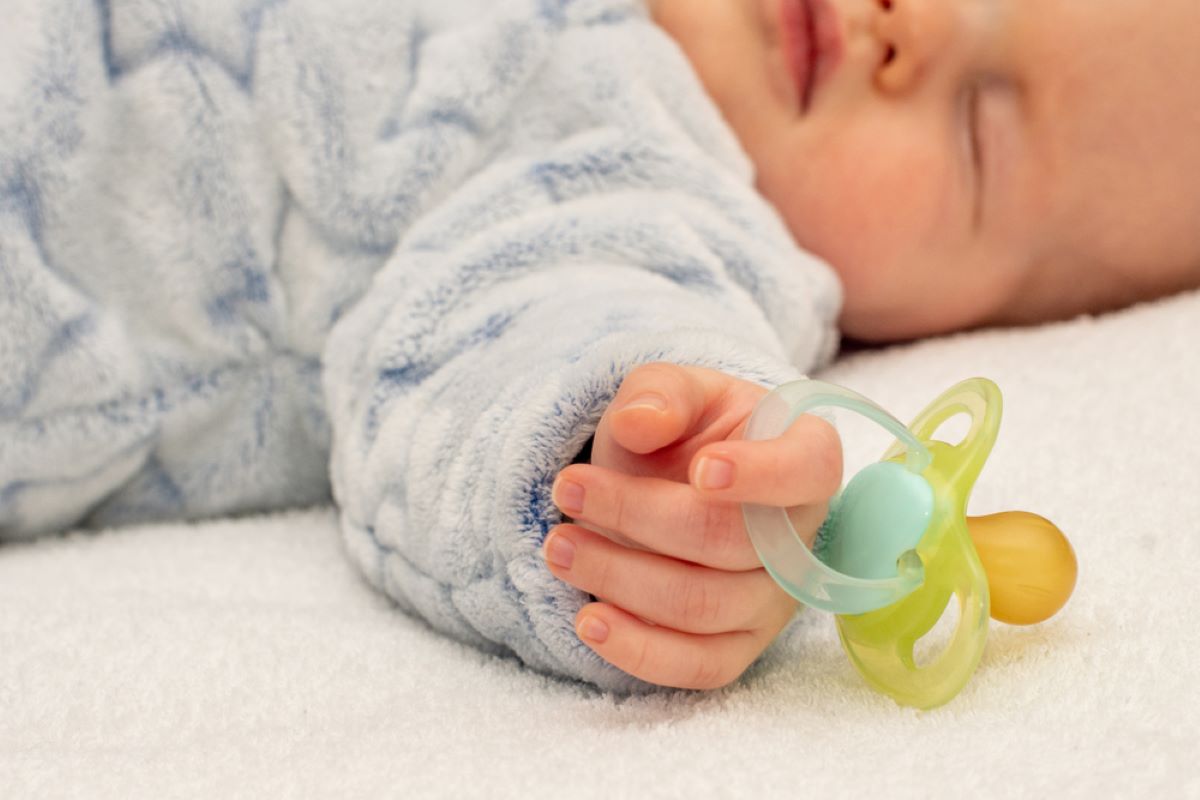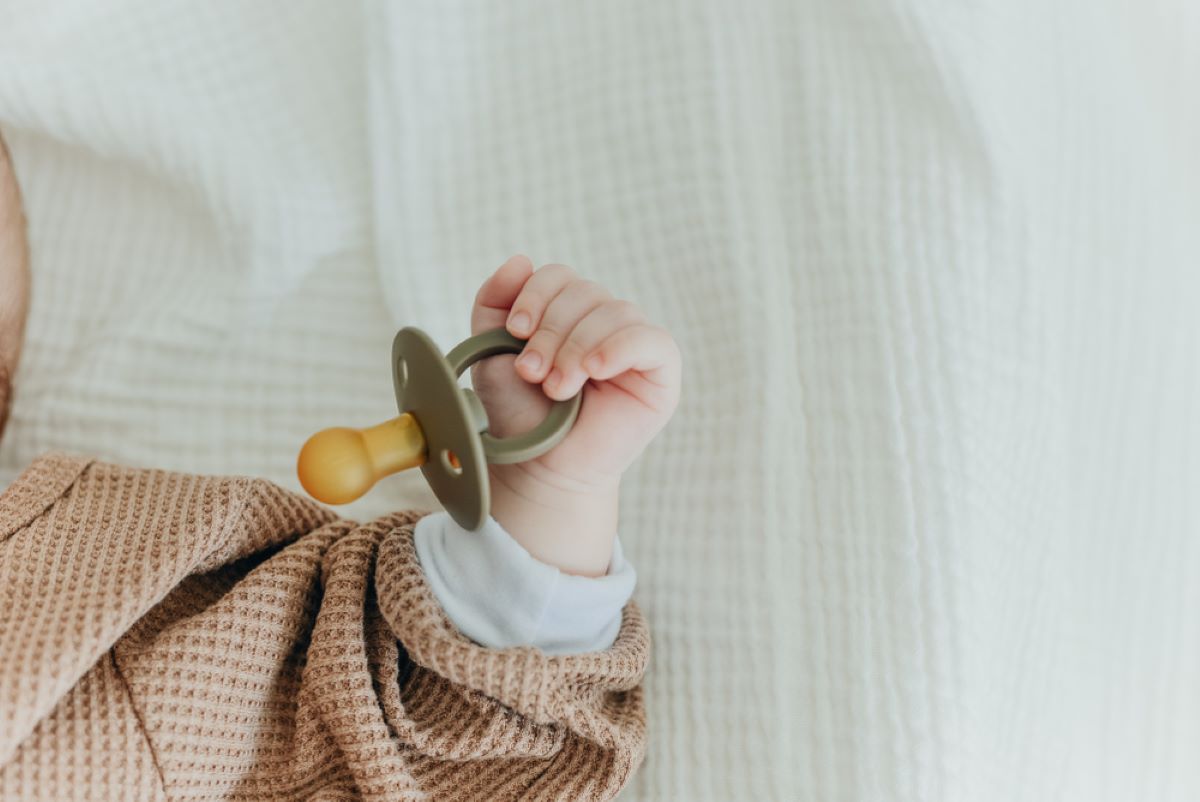How to keep a pacifier in your baby’s mouth? You’re aware it will become your best friend once your baby gets used to it, but right now, you feel like you spend most of your day picking it up and giving it back to your newborn.
You’re not alone on this one. Lots of moms struggle with the same issue and sometimes it feels like your little one is refusing to keep the pacifier in, no matter what you do.
Whether you decide to give your baby a binky or not, it’s totally up to you. This is a personal choice that moms make, but there’s no denying that they’re a lifesaver when it comes to fussy babies and sleepless nights. It’s a great tool that works like magic when you’re out of ways to soothe your little one.
Unfortunately, some babies simply can’t seem to accept a pacifier. If this is the case with your little one, just know that it takes time and patience to encourage your baby to keep one in her mouth, but it’s not impossible. Once she learns how to do it, it will become her new favorite thing. And yours, too!
If you don’t know how to keep a pacifier in your baby’s mouth and you’re completely out of ideas, I’ve got you covered. Together, we’ll learn why she keeps spitting it out, and how you can help her to keep it in, so keep on reading.
Why is my baby’s pacifier falling out of her mouth?

In order to understand how to keep a pacifier in your baby’s mouth, it’s important to find out why it keeps falling out. Once you know the cause, it will be a lot easier to find a solution. Here are the most common reasons why it happens.
1. She doesn’t like how it feels
Sometimes, your baby might be spitting out her pacifier simply because she doesn’t like how it feels in her mouth. Yes, even as young as she is, your little one can have preferences when it comes to texture, style, and the material of her pacifier.
Shopping for the right one can be pretty overwhelming. There are many styles and types you can choose from. It’s easy to get lost if you don’t know what you’re looking for. Silicone, latex, natural rubber, conventional, orthodontic… How in the world do you pick the right one?!
It’s probable that you’ll try many different options until you find out what your baby likes the best. Silicone pacifiers, for example, are pretty easy to clean and they’re odorless, which is why moms usually prefer those. However, your baby might not be a huge fan because it’s not as soft or as flexible as latex.
Latex pacifier nipple, on the other hand, is softer, but can easily retain odor which is why you’ll have to replace it quite often. If your baby is allergic to latex, you should try a different material such as natural rubber.
They’re a great choice if you’d like to keep things natural and avoid harmful toxins. They’re free of chemicals, and a lot of babies like them because they’re solid. Among the three we’ve mentioned, natural rubber pacifiers are the most expensive.
You should also pay attention to the style. The most affordable pacifiers are the ones with rounded tips. They’re great to have in stock!
If she doesn’t like how the rounded tip feels, an orthodontic pacifier might be your solution. Although it’s a bit more expensive, it’s designed to fit the baby’s mouth and give them a better grip.
Who would’ve thought that there are this many options? But don’t stress out right away and remind yourself that choosing the right pacifier for your baby is a trial and error process. However, you’ll feel great once you find out what works best for your bub and that’s all that matters.
2. Try getting one in a different size

More often than not, the wrong size of the pacifier is the main reason why it keeps falling out of your baby’s mouth. The size of the nipple plays a huge role, so try to find the right one for your little one. As I’ve already mentioned, choosing a binky can be pretty overwhelming, and size is one of the reasons why.
There are way too many options to choose from. Although this can be a problem when you’re buying your first one, you’ll be thankful for the variety of sizes as your baby grows.
Some moms forget that they need to match the size of their babies’ pacifiers with their growth, and don’t realize that that’s the reason why their babies keep spitting them out. If her pacifier is too big or too small, your baby will have issues with keeping it inside her mouth.
3. Nipple confusion
Switching from breastfeeding to bottle feeding can be pretty hard for your baby. This is often called nipple confusion. Although it might seem the same to you, your bub has different techniques when it comes to drinking from her bottle and a breast.
If she keeps spitting out her pacifier, it’s probably because she’s confused by how it feels. Although she might refuse it at first, keep trying. Using a pacifier is a great way to introduce your baby to having a new object in her mouth, which can be helpful when you want to transition from breastfeeding to the bottle.
How to keep a pacifier in your baby’s mouth

Okay, so, how to keep a pacifier in your baby’s mouth? You’ve probably heard many tips and tricks, but sometimes it’s a lot easier said than done. If you struggle with this, don’t worry. You’re not alone. The most important thing to know is that there’s absolutely nothing wrong with your bub.
Some babies simply don’t accept the pacifier, and that’s okay! Still, you shouldn’t give up just yet.
There are some things you can try before you simply accept the fact that your baby is not a fan of having a strange object in her mouth. She wants to cry freely and you can’t stop her! However, you can try a few things first.
1. Use a pacifier cord
Are you sure your baby is spitting out her pacifier, or it’s simply falling out of her mouth? It can be pretty frustrating for a baby, especially if she’s too young to know how to pick it up and put it back in her mouth.
Sometimes, a pacifier falls out of a baby’s mouth when she moves around. She still has to learn how to keep it in her mouth, and don’t even get me started on learning how to put it back in. Because of that, you often have to place it back in yourself every few minutes. Of course, it gets annoying!
If this is the case with your little one, using a pacifier cord might be the solution you’ve been looking for. While she’s awake and you’re there to supervise her, attach her pacifier to a cord. That way, it will always be close to her, even when she spits it out, just make sure she’s not sleeping with the cord still attached.
2. Try different pacifiers

Sometimes, you simply have to try out different pacifiers until you find the right one. Arm yourself with patience and go shopping. Pick out a few different types and let your baby try them out at home. That’s the best way to know which texture, material, shape, and size works best for your bub.
No one can guarantee that your baby will like the pacifier you chose for her or the one she got from her grandma when she was born. If it’s too hard or too big for your baby, she won’t accept it. Keep trying before you find the right one. Once you do, it will become your new best friend.
3. Give her some time
Listen, maybe your baby just needs a bit more time to get used to having a new object in her mouth. She needs practice or her mouth is simply not strong enough to suck on a pacifier just yet. You need to be patient and persistent.
Give your baby a dummy throughout the day and let her practice. After some time, she’ll get better at it, and her grip will become stronger, which will help her keep it in her mouth.
3 things you shouldn’t do when trying to keep a pacifier in your baby’s mouth
When encouraging your baby to use a pacifier, there are not a lot of things that you can do wrong. It’s pretty simple, and your baby will learn how to use it on her own after some time. However, there are some things you should avoid, and here are some of them.
1. If your baby’s sleeping, don’t try to give her a pacifier
Don’t place a pacifier in your baby’s mouth if she’s already sleeping. Although it’s normal for babies to fall asleep with it in their mouths, don’t force it back in if she spat it out in her sleep, as you could wake her up.
She’s not crying and doesn’t need a binky to soothe her so stop placing it back in her mouth.
2. Don’t pressure your baby to use a pacifier if she keeps spitting it out all the time
Never force a pacifier into your baby’s mouth. Although they’re a great tool to soothe your bub, they’re not miracle workers. If your baby is crying and refusing to accept a pacifier, think about any other potential reasons why she might be fussy.
By trying to place it back in her mouth over and over again, you’re probably going to make her even more nervous. And I’m sure that’s not what you’re trying to do.
3. Keep an eye on your little one every time she’s wearing a pacifier cord
Although pacifier cords can help you keep one close to your baby, don’t leave them on her if you’re not there to watch your little one while she’s napping or playing. Never let your bub sleep with a pacifier cord on her, as they pose a strangulation hazard.
